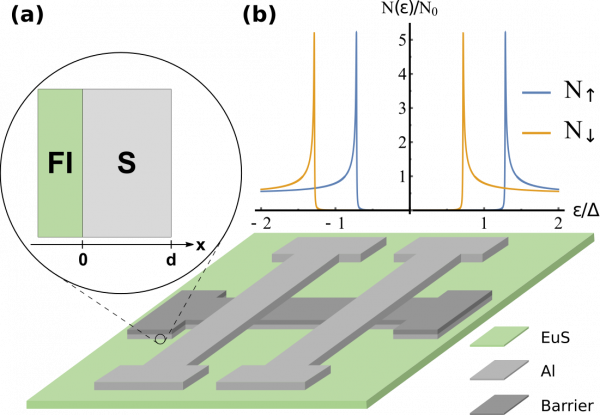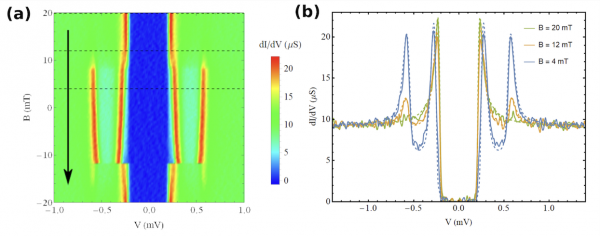Coexistence of superconductivity and interfacial exchange
The Mesoscopic Physics group, in a close collaboration with experimental colleagues, developed the theory to describe the coexistence of superconductivity and an exchange field generated at the interface between a magnetic insulator and a superconducting thin film. On the one hand, these results demonstrate the important role of the superconductor layer thickness, which is particularly relevant for the fabrication of high-quality samples suitable for applications. On the other hand, the agreement between theory and experiment demonstrates the accuracy of the present theory, which, originally developed for homogeneous situations, is now generalized to highly inhomogeneous systems.
Ferromagnetic insulators (FI) can induce an exchange field in an adjacent superconductor (S) via the magnetic proximity effect, which is due to the interfacial exchange interaction between the localized magnetic moments and the S’s conduction band electrons. Such exchange field manifests as a spin splitting. Superconductors with a spin-split density of states (DoS) are proposed for diverse applications, such as topological qubits using Majorana wires, spin valves, thermometry, magnetometers, caloritronic devices, thermoelectricity, and radiation detectors, among others.
A crucial parameter that determines the magnitude of the induced spin splitting in FI/S bilayers is the thickness of the S layer d. In very thin samples, the superconductivity is suppressed by the strong magnetism. By contrast, in very thick samples, the spin splitting is absent at distances away from the interface.
In this work, the authors calculate the density of states and critical exchange field of FI/S bilayers of arbitrary thickness. From the model presented, Hijano et al. determine the range of parameters of interest for applications, where the exchange field and superconductivity coexist. They show that for d>3.0ξs, the paramagnetic phase transition is always of the second order, in contrast to the first-order transition in thinner samples at low temperatures. Here ξs is the superconducting coherence length.
Finally, the work compares the author’s theory with the tunneling spectroscopy measurements in several EuS/Al/AlOx/Al samples. If the Al film in contact with the EuS is thinner than a certain critical value, superconductivity is not observed, whereas, in thicker samples, evidence of a first-order phase transition induced by an external field is found. The complete transition is preceded by a regime in which normal and superconducting regions coexist. The group attributes this mixed phase to inhomogeneities of the Al film thickness and the presence of superparamagnetic grains at the EuS/Al interface with different switching fields. The step-like evolution of the tunnel-barrier magnetoresistance supports this assumption.

Figure 1: (a) Typical experimental setup and schematic view of the FI/S bilayer. (b) DoS of a homogeneous spin-split superconductor.

Figure 2: (a) The differential conductance of the FI/S/I/ junction at 30 mK as a function of the external magnetic field and the voltage drop across the junction. The arrow indicates the direction of the magnetic field sweep. (b) dI/dV curves at three different values of B (B = 4, B = 12 and B = 20 mT), indicated by dashed lines in (a). The solid lines correspond to the experimental data, whereas the dashed lines to the theoretical calculation.



